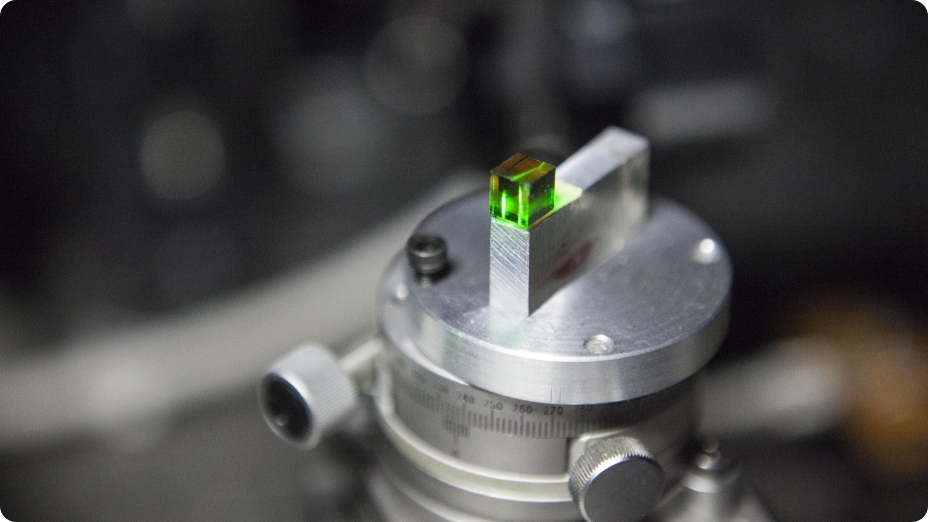In the near future, information processing will exploit the dynamic richness of non-linear of photonic systems.
Photonics has allowed for the development of the information and communication society by enabling laser-encoded data to be transmitted over great distances and then retrieved with virtually no error. Modern challenges of information processing will call for the exploration of technological solutions to increase the bit rate of data transmission while making way for a physical approach to information security.
Institut Photonique faces these challenges by specifically exploiting the richness of the non-linear dynamics of photonic systems. Non-linear dynamics corresponds is the capacity for a system to evolve in time and/or in space, potentially in a non-stationary and predictable yet still aperiodic and unpredictable way, an extreme situation called deterministic chaos. By exploiting those non-linear dynamic proprieties, we can either increase the speed at which photonic systems can process information, introduce data safety, or improve the performance of a telecommunication connection.

When light interacts with matter, as with a non-linear crystal, matter modifies its properties, thus conferring new properties to the light that passes through it. This subtle exchange between light and matter is what enables to develop new processing information solutions… photonic intelligence.
Dynamic instability in photonics offers new broadband computing and encryption solutions.
We have discovered that a laser used in optical telecommunications, typically consisting of a reduced bandwidth used to encode data, possesses the same properties as a non-linear oscillator namely the ability to generate pulsed dynamics kept at a frequency that is far higher than a few GHz, fast neural dynamics, ultra-wideband chaotic systems, etc. Fast pulsed dynamics make it possible to use laser in order to rapidly generate light for optical pulses, which is especially useful for spectroscopy, fast sensors and fast data modulation. Dynamics that mimic neural behaviour can be exploitable for neuro-inspired computing where the laser replaces the neuronal network for machine learning purposes (a solution known as photonic artificial intelligence). The chaotic dynamics of the laser enable the broadband generation of cryptographic keys used to secure information.

The power emitted by a laser can change in a completely unpredictable manner. When controlled, this dynamic allows for the broadband generation of random physical data and data encryption. Thereby, we demonstrated over 100,000,000,000 “optical” heads or tails per second generated by this laser, making it the fastest dice in the world!
Non-linear interaction of light with matter allows for the light to be self-guided
Similarly, the non-linear interaction between light and certain materials enables to activate complex spatio-temporal dynamics used for the fast and parallel optical processing of information. It can be possible for waveguides to be induced by light itself inside materials, thus allowing for matter to be transformed into a storage and optical information manipulation space. Specific solutions, “solitons”, not only enable the light to propagate without deformation inside the matter, but they also interact to create optical branches and connections inside the matter, leading to the spontaneous and reconfigurable development of optical couplers.
.

The interaction between two light beams inside “photorefractive” materials allows for the realisation of entirely optical waveguides which geometry can be reconfigured. These optical guides also allow for the construction of X- or Y-shaped couplers inside a non-linear material.
Non-linear materials enable to slow light
Light can significantly impact the dispersion property of certain non-linear materials, so that the pulse of light propagating through the material substantially reduces its speed. While light takes approximately 0.001 second to travel around Earth, a pulse of light can take up to one second to travel through 1cm of material… which is 10 billion times slower than the speed of light in air! This result will allow the conception of optical memory to slow down or even store pulses of light that propagate through telecommunications networks, replacing electronic commutators and routers.

A pulse of light (in green) is slowed down by a millisecond when passing through a 1cm-long non-linear material. This delay enables to consider the future creation of an optical router which will slow down pulses before directing them towards the correct output port.
Photo-induced waveguides, optical patterns, non-conventional beams interaction and neuro-inspired computing, photorefractive materials
Physics-based neuro-inspired computing, embedded artificial intelligence, non-linear dynamic of photonic components, data analysis, photonic systems simulation
Non-linear dynamic in semiconductor lasers, neuro-inspired computing, all-optical waveguides, slow light

